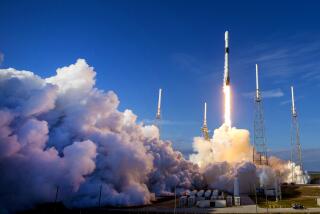SpaceX explosion: ‘Large breach’ took place in helium system in second stage of rocket

NASA said SpaceX was conducting a test firing of its unmanned rocket when the blast occurred.
- Share via
Early analysis of debris and data from SpaceX’s launch pad explosion suggests that a “large breach” took place in the cryogenic helium system of the rocket’s second-stage liquid oxygen tank, the space company said Friday.
The Hawthorne space company said it still has not determined the root of the incident and that all “plausible causes” are being investigated.
“We will work to resume our manifest as quickly as responsible once the cause of the anomaly has been identified by the Accident Investigation Team,” SpaceX said in a statement on its website. “Pending the results of the investigation, we anticipate returning to flight as early as the November timeframe.”
SpaceX said it has ruled out any connection between the explosion three weeks ago and the June 2015 disintegration of a rocket laden with supplies for the International Space Station, an incident that was blamed on a failed strut assembly in the Falcon 9’s second stage that was holding down a helium tank.
But the news Friday means the company should take a careful look at the second stage of its rockets, said Marco Caceres, senior space analyst at the Teal Group, an aerospace and defense market research firm.
“There’s a pattern,” he said. “It wasn’t the same thing, but there’s a pattern of things going wrong with a certain part of your rocket.”
The fiery failure that occurred at Cape Canaveral Air Force Station in Florida is being investigated by SpaceX, with participation from NASA, the U.S. Air Force and other industry experts. It is being overseen by the Federal Aviation Administration.
“Getting back to flight safely and reliably is our top priority,” SpaceX said on its website. “The data gathered from the present investigation will result in an even safer and more reliable vehicle for our customers and partners.”
SpaceX has said its launch schedule is filled with 70 missions worth more than $10 billion.
The explosion destroyed a Falcon 9 rocket and a communications satellite set to launch Sept. 3. SpaceX said the incident occurred while the rocket was being fueled ahead of a routine pre-launch static test fire.
Two weeks ago, company Chief Executive Elon Musk described the launch pad explosion in a tweet as “the most difficult and complex failure” the company has ever had. He said at the time that the rocket’s engines were not on.
On Friday, SpaceX said inspections of the company’s Space Launch Complex 40, where the explosion occurred, show that “substantial areas” of the launch pad were affected.
However, the Falcon support building adjacent to the pad, as well as the tanks and plumbing that hold the super-chilled liquid oxygen and kerosene fuel farm were “unaffected.”
The launch pad’s control systems were also found to be in “relatively good condition,” SpaceX said.
The state of the launch pad is good news for the company since important systems weren’t affected, Caceres said.
SpaceX said the modifications to its alternate launch pad at Cape Canaveral are still set to finish in November, and Caceres said he expected the company to launch from there.
For more business news, follow me @smasunaga
ALSO
SpaceX says rocket launches could resume as soon as November
Blue Origin’s new, more powerful rocket will compete with SpaceX
Pointing at SpaceX explosion, ULA says Pentagon contracts shouldn’t just go to lowest bidder
UPDATES:
1:10 p.m.: This article was updated with comment from an analyst and additional detail about the investigation.
This article was originally published at 12:35 p.m.
More to Read
Inside the business of entertainment
The Wide Shot brings you news, analysis and insights on everything from streaming wars to production — and what it all means for the future.
You may occasionally receive promotional content from the Los Angeles Times.











